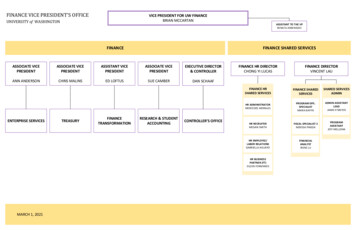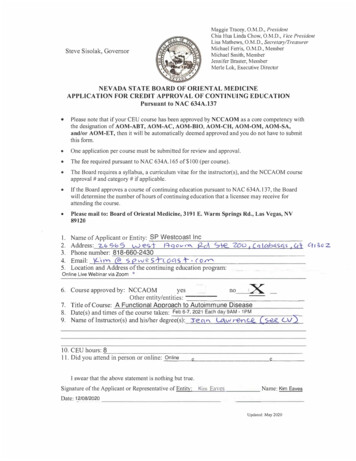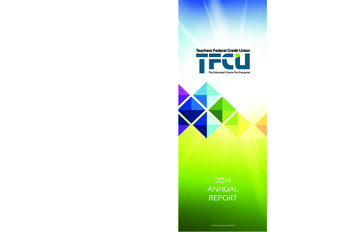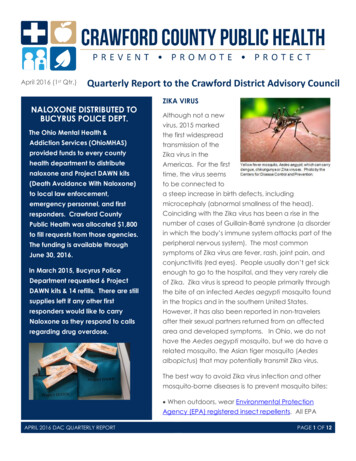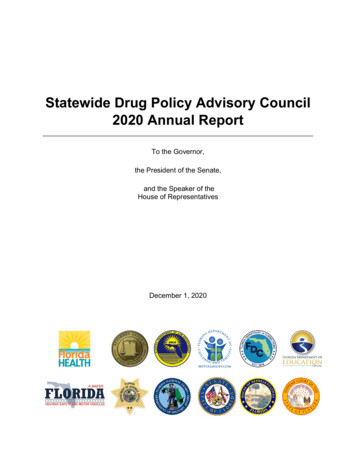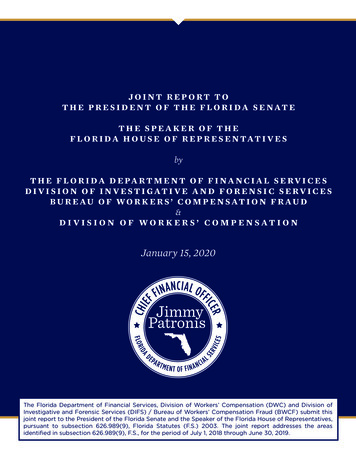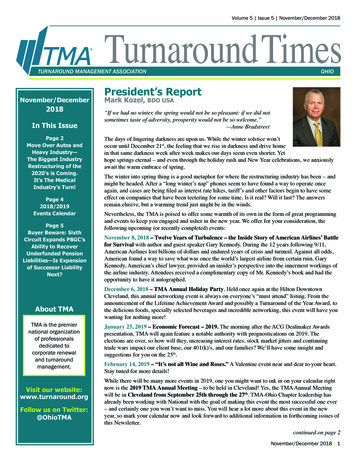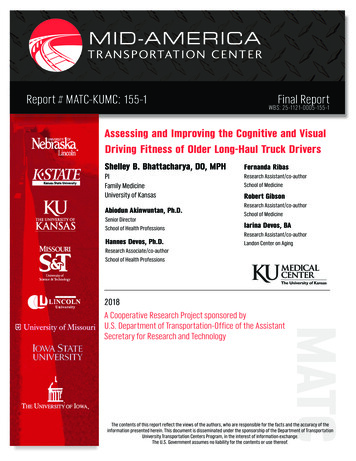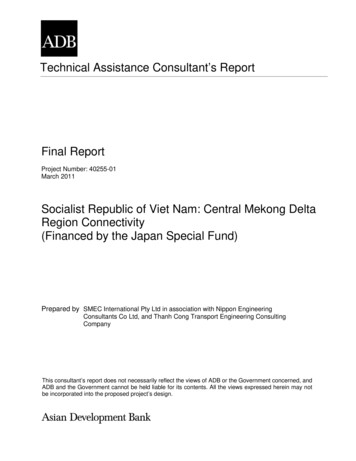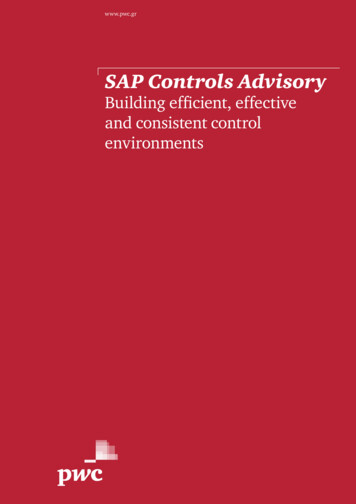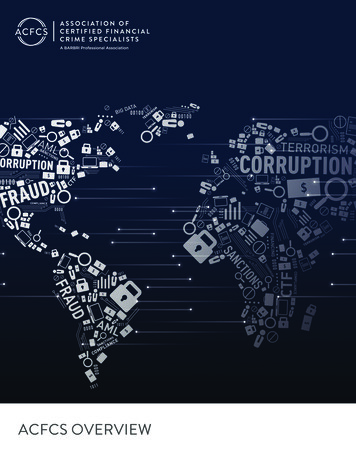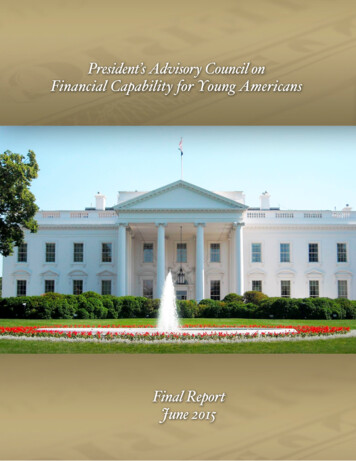
Transcription
President’s Advisory Council on Financial Capability for Young Americans1
President’s Advisory Council on Financial Capability for Young AmericansTABLE OF CONTENTSMEMBERS . 3CHAIRMAN’S LETTER . 4EXECUTIVE SUMMARY . 6INTRODUCTION . 7CHARTING THE COURSE . 14RECOMMENDATIONS AND IDEAS IN ACTION . 16Summary of Recommendations . 17Council Ideas in Action . 20ACKNOWLEDGEMENTS. 25APPENDIX A: Report of the “Financial Education for Children, Building theGroundwork for Financial Knowledge (Pre K-12)” Working Group. 28APPENDIX B: Report of the “Preparing Young People to Make Decisions about PostSecondary Education That Prepare Them for Financial Independence” Working Group. 31APPENDIX C: Report of the “Leveraging Cities and Communities For FinancialCapability Leadership” Working Group . 43APPENDIX D: Report of the “Encouraging Innovation and Technology to PromoteFinancial Capability Products and Tools for Young People” Working Group . 51APPENDIX E: FINANCIAL CAPABILITY BEST PRACTICES AND RESOURCES 56APPENDIX F: RESOURCES AND TOOLS . 59APPENDIX G: FEDERAL FINANCIAL CAPABILITY INITIATIVES . 652
President’s Advisory Council on Financial Capability for Young AmericansMEMBERSThe Council is composed of the Secretary of the Treasury, the Secretary of Education, theDirector of the Consumer Financial Protection Bureau and the non-governmental memberslisted below.John W. Rogers, Jr., Chair of Council, Chairman, CEO and CIO, Ariel InvestmentsJosé Cisneros, Vice Chair of Council, Treasurer, City and County of San FranciscoTed Beck, President and CEO, National Endowment for Financial EducationSherry Salway Black, Senior Advisor, National Congress of American IndiansJohn Hope Bryant, Founder, Chairman and CEO, Operation HOPEAnna Maria Chávez, CEO, Girl Scouts of the USAMichael L. Corbat, CEO, Citigroup, Inc.Kerry N. Doi, President and CEO, Pacific Asian Consortium in EmploymentRobert J. Glovsky, Vice Chair and a Principal, The Colony GroupTed Gonder, Co-Founder and CEO, MoneythinkRichard G. Ketchum, Chairman and CEO, Financial Industry Regulatory AuthorityBeth Kobliner, Personal Finance Journalist and AuthorLillian M. Lowery, Maryland State Superintendent of Schools, Maryland StateDepartment of EducationKilandigalu (Kay) M. Madati, EVP, Digital Media and Chief Digital Officer, BETNetworkMarc H. Morial, President and CEO, National Urban LeagueDeanna M. Mulligan, President and CEO, The Guardian Life Insurance Company ofAmericaCarol E. Quillen, President, Davidson CollegeAmy Rosen, Partner, Public Private Strategy GroupCharles W. Scharf, CEO, Visa Inc.Brad D. Smith, President and CEO, IntuitRegina Stanback Stroud, President, Skyline CollegeJason W. Young, Co-Founder and CEO, Mindblown Labs3
President’s Advisory Council on Financial Capability for Young AmericansCHAIRMAN’S LETTERThe Honorable Barack ObamaPresident of the United StatesThe White HouseWashington, D.C.The Honorable Jacob J. LewSecretary of the TreasuryDepartment of the TreasuryWashington, D.C.Dear Mr. President, Secretary Lew, and fellow citizens:I have been honored to serve as Chairman of the President’s Advisory Council on FinancialCapability for Young Americans. During the two years of the Council’s charter, we haveexamined the state of financial capability among the nation’s young people and now submitto you our recommendations for action and dissemination.We are guided by the principle that all American young people must be equipped with theknowledge and skills necessary to make smart decisions about their finances. Ourrecommendations address a broad range of important issues: Provide and improve access to financial education, services and products,particularly for underserved Americans.Use technology to improve scalability and enhance the effectiveness of proventactics.Build and enhance what exists, identify gaps and offer improvements.Collect and share knowledge to ensure that no one should have to start from scratchin the field of financial capability.To tackle these issues, the Council conducted its activities through four working groups. Ledby Marc Morial, the Financial Education for Children Working Group developed a plan topilot a demonstration that tests the hypothesis that if teachers become more comfortable andconfident with personal finance topics and better understand effective strategies for teachingthese topics, then they will be more competent in teaching them to students.Carol Quillen led the Post-Secondary Education Working Group, which focused on helpinglow-income and minority youth to make informed decisions about post-secondaryeducation. They developed a design brief for tools to aid students in making financialdecisions around higher education and how to pay for it.Council Vice-Chair José Cisneros led the Cities and Communities Working Group. Thisgroup focused on the important role that cities and communities play in building financialcapability, which extends to building financial education into youth training andemployment programs, supporting and promoting Child Savings Accounts policy andprograms, and taking action to protect young people from financial abuse.Across all of the working groups, the Council sought to incorporate innovation andtechnology to promote financial capability products and tools for young people in order toimprove scalability and enhance the effectiveness. Charles Scharf led the Technology4
President’s Advisory Council on Financial Capability for Young AmericansWorking Group, which worked closely with the other working groups to develop theirrecommendations, including the teacher training demonstration project, post-secondarydecision-making tool, and specific technology-based actions to expand financial access tomillions of un- and underbanked young Americans.Throughout this work, I have personally identified two opportunities of utmost importance.First, it is important that children study financial topics in public schools starting at an earlyage. Second, we must encourage financial service companies, local businesses, nonprofitproviders, foundations and other professionals to foster partnerships with schools tostrengthen learning opportunities and provide mentors and role models for children.In addition to recommendations and ideas into action that support these areas ofopportunity, the Council has highlighted cities and states that are making progress towardstrengthening financial education in public schools and fostering school partnerships withprivate sector partners: Chicago: In March 2015, the Council recognized Chicago as a ‘model city’ for itscommitment to developing a citywide comprehensive financial education strategy. Overthree years, the Chicago Financial Education Initiative will bring together city agenciesand financial education providers for the first time to develop and enact a plan to makefinancial education accessible to all youth, parents and community members in Chicago.Baltimore: In May 2015, the Council highlighted the value of integrating financialconcepts throughout the K-12 curriculum, such as those in place in Maryland, to prepareall youth to be financially capable adults and college and career ready.New York City: In June 2015, the Council highlighted the importance of financialliteracy education for K-12 students and noted a partnership between the Council forEconomic Education and W!SE to provide financial literacy certification to high schoolstudents.In sum, our young people deserve to have the knowledge, skills, and confidence tosuccessfully handle their personal and household finances as they grow into adulthood.Financial capability empowers us as citizens of a democracy. It allows us to betterparticipate in critical policy debates that will shape our future for decades to come.Sincerely,John W. Rogers, Jr., Chair5
President’s Advisory Council on Financial Capability for Young AmericansEXECUTIVE SUMMARYExecutive Order 13646, signed on June 25, 2013, created the President’s Advisory Councilon Financial Capability for Young Americans to advise the President and the Secretary ofthe Treasury on how to promote the financial capability of young Americans. Financialcapability means having the requisite knowledge, skills and access to manage financialresources prudently and effectively. In order to promote financial capability, we recommendways to empower individuals to make informed choices; plan and set goals; avoid pitfalls;know where to seek help; and take other actions to better their present and long-termfinancial well-being. We also take into consideration the particular needs of traditionallyunderserved populations, recognizing that building financial capability is especially criticalto enable upward economic mobility.Our Council focuses on encouraging financial capability among young people in schools,families, communities and the workplace. By starting early, young people can learn thedifference between wants and needs, the power of saving, and the productive role thatmoney can play in their lives. Age-appropriate money skills and habits will make our youngpeople better equipped to tackle more complex financial decisions regarding the financing ofhigher education and saving for emergencies and retirement. These decisions have lastingconsequences for financial security.This report first summarizes our findings on why building the financial capability of youngpeople is important and the challenges that young people are facing. The report thenidentifies current progress and promising approaches in the area of building financialcapability. Subsequently, the report explains our recommendations and commitments,called Ideas in Action, for further progress. These include the following: We note ways to better prepare teachers to implement financial education in theclassroom using the power of technology.We identify the importance of equipping young people with both information andguidance so they can navigate the critical and complex decisions related to postsecondary education and how to pay for it.We recognize the uniquely powerful roles that cities and communities can play likeconnecting young people to appropriate financial products and tools through youthemployment programs.We appreciate the need to assess how to better protect the identity and credithistories of young people.Our recommendations are based on evidence of effectiveness; and accordingly, details ofour research findings and reasoning are located in the appendices as each subcommittee’sworking group report.We hope that the recommendations, ideas in action, and resources identified in this reportwill spur progress by the President, his Administration, and various levels of governmentand organizations across sectors toward improving the financial capability of more youngAmericans.6
President’s Advisory Council on Financial Capability for Young AmericansINTRODUCTIONWe are honored to serve in an advisory capacity to President Barack Obama, whoseinvestment in American financial capability is demonstrated by his appointment of twoPresidential Advisory Councils on this matter. Each Council builds on previous work,including that of the Council appointed by President George W. Bush in 2008.The 127 million young Americans under age 30 1 represent America’s workforce of todayand tomorrow. They help drive our economy and their actions will shape confidence andgrowth for our country. How they use and understand financial resources, and theirabilities to obtain education and jobs, manage debt and daily expenses, overcome setbacksand plan and invest in their futures are a concern for the nation as a whole. The Councilhopes the findings and ideas in this report contribute to attaining a more financially capablepopulation.What We Know About Young Americans’ Financial CapabilityYoung Americans are part of the global economy and workforce. Their financial skills andknowledge will determine how successful our economy will be in the years ahead.However, there is reason for concern. Fifteen-year-old American students fell short of globalfinancial literacy expectations in 2012 in the first large-scale global financial literacyassessment. The Programme for International Student Assessment (PISA) evaluatedstudents in 18 countries on their ability to apply mathematical skills and basic financialconcepts to real world situations. The United States’ mean score ranked ninth; ShanghaiChina ranked first; and Colombia ranked last. As troubling as these findings may be, theunderlying facts demonstrate a concerning picture of the disparities in financial capability bysocio-economic status in the United States. According to the PISA study, low-income andminority students were much more likely to score lower than their peers. 2Beyond the data presented by the PISA, many data points show that Millennials — youngadults — are struggling more than older generations with money management and financialliteracy. For example, Millennials have a higher rate of being unbanked than oldergenerations, and they are less likely to pay off their full credit card balance at the end of eachmonth, as well as demonstrating other signs of financial stress. 3 These discrepancies mayhinder Millennials’ opportunity and ability to attain economic mobility and financialstability.12013 American Community Survey, U.S. Census Bureau.For example, 8.5 percent of white students scored below proficiency level 2 (out of 5 score-basedachievement levels)2, compared to 37 percent of African American and nearly 27 percent of Hispanic students.Conversely, 14 percent of white students scored at the top level, compared to an overall average of 9.4 percentof students, and a statistically insignificant percentage of minority students who attained that a2012highlights 12.asp.32012 National Financial Capability Study (State-by-State Survey), FINRA Investor Education Foundation.www.usfinancialcapability.org.27
President’s Advisory Council on Financial Capability for Young AmericansOur concern with low-income and minority youth is true of young adults as well. Femaleand minority young adults lag behind their male and white peers; and lower-incomemillennial households are financially stressed more than their higher-income peers. 4Young people of color particularly show evidence of financial challenges. For example,compared to whites, they are more likely to spend more than their income and are morelikely to have student loan debt. Lower-income young households find it more difficult tomake ends meet, and are less likely to have retirement accounts, mortgages, non-retirementinvestment accounts or rainy day funds. 5While evidence is scarcer on the financial capability of children under age 15, we believethat today’s teens and young adults who lack financial capability not long ago were childrenwho did not have opportunities to gain financial knowledge and skills. Despite the clearneed for financial education for young people to make sound decisions and have morepositive outcomes, too many children do not obtain financial education early in their lives.Preparing Young Americans for the FutureGiven the challenges that young people face, it is clear that financial capability holds greatvalue to individuals, communities, and the nation as a whole. Building financial capabilityfor youth better positions them for the critical crossroads that they will face – whetherdeciding how much to spend or making an informed decision about post-secondaryeducation – and enables them to improve their financial well-being.All of these choices can have long-term impacts on financial well-being and opportunitiesfor upward economic mobility. Educating children early, as part of their elementary andsecondary education, is critical to prepare them for the paths they will take as adults. Inearly adulthood, young people generally make financial decisions that have long-termimpacts at two critical junctures: choosing post-secondary education and managing theirfirst earnings. All young people should thoughtfully evaluate educational options andincome potential. In order to do so, we must provide them with sufficient information tounderstand the consequences and implications of their choices. It is evident thatinformation and understanding can be enhanced by the opportunity to gain hands-onexperience with real financial products and services that meet their needs and allow them togain experience in money management.The financial well-being of young Americans can be greatly enhanced by higher learning.Yet, financing higher education, particularly four-year programs, poses its own set offinancial questions. As tuition and associated costs have escalated, so has studentborrowing. 6 Preparing young people means addressing this issue. Student debt cancompromise their ability to handle unexpected expenses caused by job loss, economic4Mottola, Gary R. The Financial Capability of Young Adults—A Generational View. March 2014. FINRA InvestorEducation Foundation alCapabilityofYoungAdults.pdf.5See above.6According to the 2011-2012 National Postsecondary Student Aid Study, 71 percent of young adults financepost-secondary education with debt (http://nces.ed.gov/pubs2013/2013165.pdf).8
President’s Advisory Council on Financial Capability for Young Americansshocks and medical events. Although financial capability cannot remove these commonchallenges, it will equip young Americans to be knowledgeable when they arise.Fortunately, young Americans live in a technology-rich and highly interactive world thatprovides ample access to information. Over 80 percent of American teens and upwards of90 percent of young adults own smartphones. 7 For these young Americans, technology isnot merely a tool. It fundamentally shapes the way in which they interact with the world. Ayoung person can order food online, buy movie tickets, hold a text conversation with his orher closest friend, and rent a car all from a mobile device. This resulting generation ofdigital natives has extremely high expectations around technology and incorporates it intoevery aspect of their lives.Perhaps more importantly, technology has significantly impacted the way in which thesestudents learn. In a world where people can access information anytime and anywhere, it isfar less important that today's students — the workers of the future — memorize facts andfigures. It is absolutely essential that they possess the skills and mindset necessary to seekout, critically analyze, synthesize, and apply the right knowledge at the righttime. Consequently these same attributes are key to consumers’ ability to effectivelymanage their financial lives in an increasingly complex and rapidly changing financiallandscape.In recent years, the broader education community has begun to recognize that today'stechnology-rich environment has huge implications for how students learn, and has begunto incorporate blended learning strategies to better meet students’ needs
secondary education and how to pay for it. We recognize the uniquely powerful roles that cities and communities can play like connecting young people to appropriate financial products and tools through youth employment programs. We appreciate the need to assess how to better p
